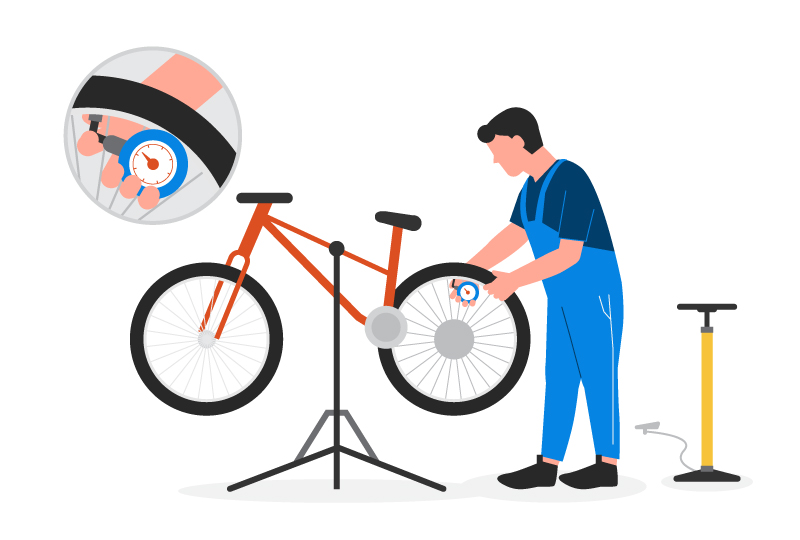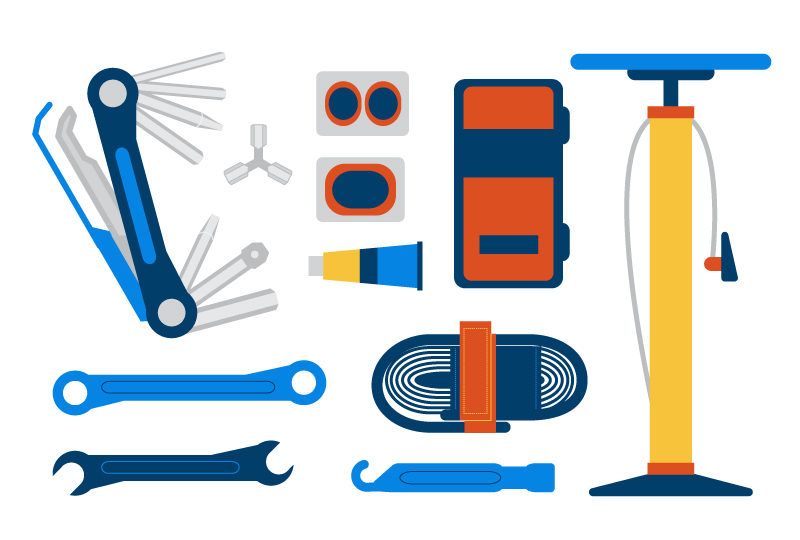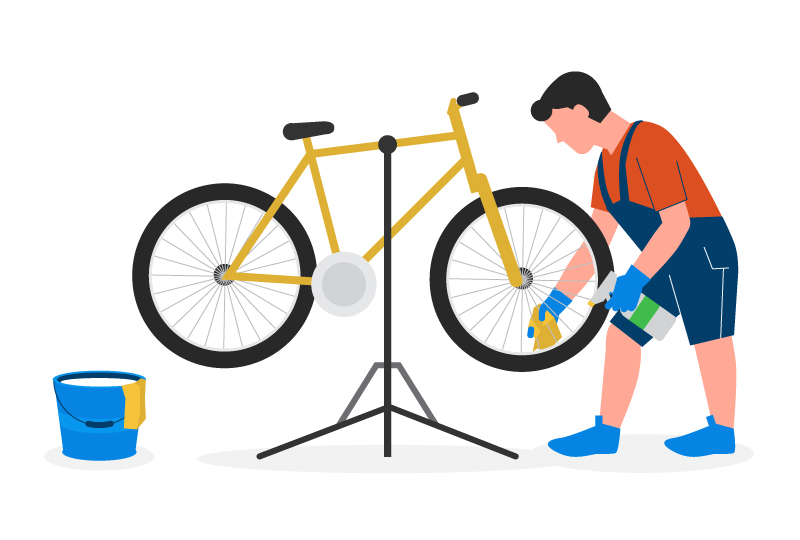A good rider must do away with the annoying sound of rattling metal, and the disgusting outlook of a muddy bike. Maintaining and caring for your bike is not an easy task. The necessary skills are, however, easy to learn if you are determined.
Good bicycle care not only reflects your personality as an individual but also works in your favor. For instance, you will prolong your bike’s lifespan. You wouldn’t want to spend your time and money buying and replacing worn out parts when you can prevent it!
Table of Contents
Inspect Your Bike
Build the best defense against loose parts by normalizing proper inspection before hitting the road. This routine will help you catch and adjust potential setbacks, which might cause safety hazards.
Here is how you should inspect your bike.
Checking The Tire Pressure
Nothing is worse than stopping for a flat tire change when you are running late for work. It is even worse if you get to work in sweat because of paddling a lot more to keep a good speed. Therefore, ensure you have a floor pump with a pressure gauge in case you have to inflate your tires.
Start by checking for the suggested pressure on the sidewall of your tire. The rear tire should have more air than the front because it supports your weight. After ruling out the possibility of a flat by deflation, look out for any other wear or damage.
You should check for the tire pressure at least once every two weeks if you use the bike frequently. However, if you don’t intend to use your bike for a long time, remember to keep the tires inflated during the pause or take them off entirely to prevent cracks on the sides.

Checking The Brakes
There is no doubt that good brakes are vital. Learn the golden rules of brake adjustment regardless of the kind of brake system you are using. In all cases, ensure that the wheels are sitting straight in the dropouts.
Then squeeze the front and back levers to ensure that the brakes are tight and that they engage smoothly before leaving. Check your brake pads as well since they are prone to overtime wear-outs. If your brakes are soft, your pads require a replacement.
Lubricating Your Bike
Save your ears and ease your travel by oiling and greasing the moving parts. Lubrication protects the components of your bike from friction, freezing, and also keeps rust and corrosion at bay.
Always remember the order in which you apply the lubricant if you are dealing with many parts. Be careful not to over-lubricate since it can cause reduced performance. In excess, the lube attracts dirt and other damaging abrasive material.
Therefore, remember to wipe off the excess lube before taking a ride. Most importantly, wipe off your chain afterwards to get rid of the excess grease build-up.
Securing Loose Bolts
You can avoid the squeaking and banging sounds by keeping all your screws, bolts and nuts tight. However, beware of your torque specs to avoid over tightening them. Carry spare nuts and bolts in case of a breakdown or replacement.
Checking The Seat Post
Consider your size, height, the terrain, and your riding style while adjusting your seat post. Ensure that your seat position allows efficient pedalling and full utilization of the strength of your legs.
Rewrapping The Handlebars
Although they are critical contact points on a bike, most riders overlook them. Riders never find it necessary to replace worn-out tapes even though they are cheap to replace.
Quality handlebars ensure you get a good grip during a ride. These are equivalent to a car’s steering wheel. You can also make your bike lavish by replacing the old with fresh bar tape.
Basic Bike Repairs
Tools
Before hitting the streets, ensure that you prepare a correct tool collection. Such appliances come in handy during long rides, or to areas where facilities such as repair shops are unavailable.
Below are examples of tools you should have.
Spare Tube And Patch Kit
Although flats are typical, you never see them coming sometimes. Therefore, a patch kit will come through for you during small punctures. For massive blowouts, you’ll have to replace the tube.
Tire Levers
When fixing the bike after having a flat, you need a tire lever to pry a tire off your wheel’s rim.
Bike Pump
After you fix your tube, you’ll need the pump for inflation. Taking a small pump on rides with you will be a lifesaver!
Bike Multi-Tool
This all-in-one tool is a must-have. It prevents you from riding around with separate tools clattering against each other. Instead, you’ll have your screwdrivers, a chain tool, and a variety of Allen wrenches fitting in an on-bike saddle pack.

Fixing A Puncture
Punctures are inevitable for riders. Therefore, every self-respecting biker must know how to fix a puncture, whether you have the necessary tools or not. However, having tools and spares with you prevents panics.
During a blowout, compose yourself and flip the bike to inspect how extensive the damage is and to check the cause of the puncture. Use the levers to get the tube out of the rim and look for the exact rapture spot. After finding the hole in the tube, mark it to avoid missing the place.
Lightly rub the place against sandpaper to provide a better surface for the rubber solution. After that, apply glue around the patch and wait for a minute or so for it to get tacky. Then put the patch over the hole and hold it in place for a minute, and then let the glue dry off for about five minutes.
You have to check if the repair is holding by slightly pumping air into the tube. While on it, ensure that the tube does not nip in between the tire and the rim. If it’s okay, push the tube into the tire, put it on, and ride off.
Fixing A Broken Chain
Fix your chain by identifying the damaged link first, and then using a chain tool, squeeze out the pin that holds the broken outer link into the next inner link. Ensure that they face in the opposite direction.
Attach a plate onto them and link them together. Add tension to the chain by putting weight on the forward pedal while holding the rear still. By doing so, the plate will snap into place.
Keep It Clean
Treat your ride to a good wash after a long day on the road. It’ll look better, last longer, and ride smoother. There are several ways of cleaning your bike. You can go for bike-specific pressure washers that have a motor and water tank.
Unlike the standard pressure washers, this tool does not force water on the bearings. You can use frame polish sprays to protect your bike from getting blemishes and stains after you are done cleaning.
Here is how you should clean your bike.

Brush Off
Clean the whole bike using a soft brush. Use a smaller brush for narrow spaces. Pay attention to the undersides since they hide a lot of dirt.
Rinse And Apply Detergent
Use a hose pipe or a bucket and sponge to wash off the mud and grime build-up. Spray the detergent along the main tubes and dirty areas.
Clean The Frame
Use a sponge and water to wipe it. Using a bike cleaning detergent, spray the bike and leave it for some time. Scrub the dirt off with a brush and water.
Clean The Rims And Pads
Wash the rims on the wheels and wipe the pads to get rid of the grime that could damage the braking surface. Spin the wheel while throwing clean water at it to rinse off all the detergent on the treads. Check if there’s any remaining dirt and rinse it off.
Dry
Move the bike into its stand and use a cloth to dry the bike. Focus on the metal parts such as the frame.
Lubricate
Turn the pedals while applying lube on the chain and the pivot points on the derailleurs. Wipe off any excesses.
Basic Care Tips
Show love, concern, and affection to your bike if you want a more extended service.
The Dos
- Clean your bike regularly
- Check the tire pressure before riding
- Tighten nuts and bolts
- Check the breaks
- Replace worn-out components
The Don’ts
- Don’t loan out tools
- Don’t touch disc-brake pads; it’ll decrease its braking power
- Solvents should not be used to lube chains
- Don’t ignore any noise from your bike
Give Your Bike A Little TLC
There isn’t any excuse whatsoever why you shouldn’t take care of your bike. Just like you need tender love and care, so does your bike.
Booking your bicycle for servicing, cleaning it, and giving it new tires can make a difference. Try it out.

